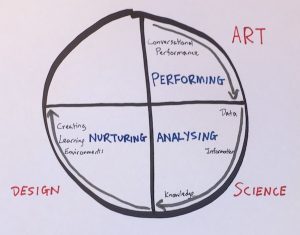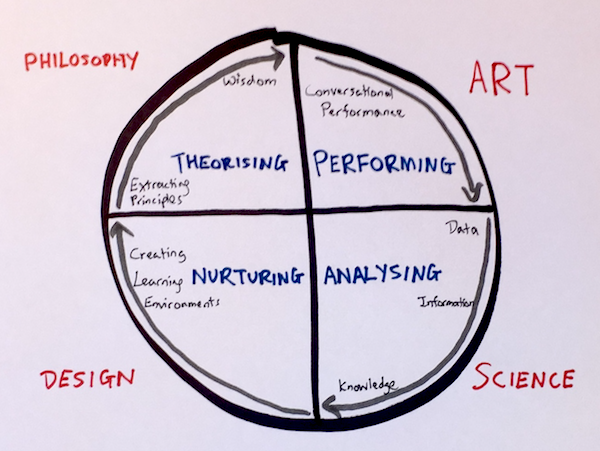The Reimagining Education in Psychotherapy (REP) Series, Part 5.
In the previous article (REP part 4), I made the case to be playful and tolerance for mediocrity as part of the learning journey.
To see the previous posts on the Reimagining Education in Psychotherapy (REP) series, click on the following:
1. Kindling the Flame
2. Teach the 3 Types of Knowledge and Not Just 1
3. Measure Growth, Not Competence
4. Lego for Psychotherapists
In this post, I propose a more spacious view of how we can reimagine education in psychotherapy, which I call the Clock of Learning Across Disciplines (CLAD).
Real life does not model after universities. While higher education attempts to bring structure and order into formal education, real life spans across disciplines.
For the training of psychotherapists, it is not just helping trainees become “scientist-practitioners,” as we would often say. In this article, I make the case that we need to sweep the Clock of Learning Across Disciplines (CLAD), starting from Art, Science, Design and Philosophy. The input from one domain becomes the output for the other.
ART: The Performing

We start at midnight, by first entering the conversational nature of therapy as an art form.
Conversation is fundamental to the social realm of therapy, but it serves a specific intention of healing for the client/patient. Within this ritual, 2 parties or more enter into this pre-defined space that is sanctioned by the healer and professional governing bodies that say this is a safe and confidential space for a person to work through their challenges.
I consider therapy as a conversational performance because unlike normal chit chat, there is a specific aim and directionality of promoting healing for a person, coupled with both parties dancing back and forth with a disposition of openness to emergent possibilities.
The conversational nature of reality formation in therapy involves the improvisational performance—the not yet seen ahead of time—between two people or more.[1] As such, the improvisational nature of therapy requires a mindset of appreciation, responsiveness, and surrender.
One has to be appreciative of the limits and resources that he or she brings into the conversation; responsive to the ebb and flow, each left and right turns, or even u-turns, and still be able to focus on the general direction, and balance all of that without imposing a rigid reality. Finally, we need a quality of surrender towards the uncertainty, much like driving in a pitch dark road with only your headlights on; the only way to see further is to proceed further with prudence.
I consider the emotionally charged endeavor of therapy as Art because it requires a tendency towards being open to experience and with an active engagement of bringing your gifts to bear. Said in another way, art is a process of bringing various elements together and ultimately growing it into a gift with the potential to transform someone.
In Art, we engage in a performing role.
SCIENCE: The Analysing

Science learns from the performance of Art, by forensically codifying the social and experiential activity of therapy, and translating that into data. That data is then churned into information, and in turn that information is analysed into knowledge.
DATA -> INFORMATION -> KNOWLEDGE
In the realm of Science, hypothetical thinking, or developing smart hunches, is highly encouraged so as to test out ideas, consider existing evidence in light of the new knowledge, and form new questions to pursue.
While the domain of Art is less organised—messy in fact— Science moves in an organised and systematic process with the aim of developing tentative ideas about reality, and test them further.
The realm of science need not be seen as a disparate process of therapy, and neither is it enough be be a “scientist-practitioner” as we shall see in the next two domains.
In Science, we take on an analysing role.
DESIGN: The Nurturing

Design is not just about beautification or “prettification”. Design is a way of intersecting form and function. One of the pioneers in decision science Herbert Simon [2] says,
“The proper study of mankind is the science of design.”
Design takes the fermenting knowledge gleaned from the performative role of Art, and analytical knowledge gained in Science, and shapes a conducive environment for deep learning to not only take place, but to architect a sustainable system that promotes adaptable learning.
As a therapist, you want to think about designing deep learning environment that is personalised towards your growth edge. Playfulness is encouraged.
Our world can be organised into either by default or by design. If left to “by default”, real learning that translates into better outcomes rarely happens. In fact, evidence shows that even though we feel like we are getting better with experience, on average, our effectiveness gets worse over time! [4]
When we make a choice, that is “by design” we actively begin to shape our internal landscape and external environment that facilitates development. Perhaps a useful way to see the role of Design is to think of yourself as a gardener. You are creating a nurturing environment that promotes growth.
In Design, we mother nature.[3] We think in terms of nurturing.
PHILOSOPHY: The Theorising

We have reached the final discipline in the Clock of Learning. The domain of philosophy is to take the inputs from Arts, Science, and Design, and convert the knowledge into wisdom.
DATA -> INFORMATION -> KNOWLEDGE -> WISDOM
The activity of theorising requires the ability to not just think in analogies, but also to be able to extract first principles (see previous articles on Principles) from the inputs of the 3 previous domains. Philosophy must not only include what is learned from Art and Science regarding “what we have learned”, but also from Design regarding “how we learn”.
In the Clock of Learning Across Disciplines (CLAD), what we develop in Philosophy—the ideas, concepts, heuristics, principles—feeds back into the performative role of Art.
In Philosophy, we engage in theorising.
Divergence to Convergence
In the right half of CLAD, as you proceed further to 3 o’ clock, there is a quality of divergence, or widening of your lens, experimenting and testing out the variation of ideas at play. In the left half, as you approach 9 o’ clock, you start to pull what you’ve learned. This process of convergence, or narrowing of your focus, helps you hone in and select key ideas that can guide your work, and at the same time, promote ongoing development.
Idiographic and Nomothetic
Next, if you dissect the CLAD horizontally, the top half is generally more idiographic. The idiographic approach focuses on the individual [5], studying in detail not only the idiosyncratic way of how you work in therapy (i.e., Art), but also what we can we understand from your data (i.e., Science). On the bottom half of CLAD, the nomothetic approach attempts to generalise the knowledge and see how it fits with the larger patterns of outcomes and process research in psychotherapy.
The Virtuous Circle
It is critical to understand that the Clock of Learning Across Disciplines (CLAD) emphasizes the need to move in a virtuous circle. Each domain and its constituent chain of events/activities informs the next, reinforcing themselves through a feedback loop.
Why Do We Start with the domain of Arts?
One curious observation you might make is why start with Art? In the traditional banking model of education (see Kindling the Flame article), by and large we adopt a deductive approach, that is we start with the theory, research, then move into practice.
I argue that even though to some degree we need a handful of fundamental ideas in our bag before we begin, we need to consider the implications of taking an inductive approach instead. For instance, by imposing other master therapist’s theories beforehand into the learner’s mind, we fail to recognise that even though these theories are useful, they are often developed after the fact. When we start with theories and over emphasise on them, we inadvertently lure trainees into a formulaic view of therapy.
Instead, we must take heed of what Milton Erickson (1983) said,
“Develop your own technique. Don’t try to use somebody else’s technique. . . Don’t try to imitate my voice or my cadence. Just discover your own. Be your own natural self. It’s the individual responding to the individual. . . . I’ve experimented with trying to do something the way somebody else would do it. It’s a mess!
Footnotes:
image by Prateek Katyal, taken in Bhutan.
[1] The word ‘improvisation’ originates from the Latin ‘improvisus’, meaning ‘not seen ahead of time’
[2] Herbert Simon, 1988 from p. 82
The Science of Design: Creating the Artificial
Author(s): Herbert A. Simon
Source: Design Issues, Vol. 4, No. 1/2, Designing the Immaterial Society (1988), pp. 67-82 Published by: The MIT Press
Stable URL: http://www.jstor.org/stable/1511391
Accessed: 15-11-2016 12:38 UTC and pg 138 of the edited book, 3rd ed. The Science of Design: Creating the Artificial, from the book THe Sciences of the Artificial, 1996
[3] I borrowed this phrase from Neri Oxman.
[4] Here’s the study by Simon Goldberg and colleagues.
Goldberg, S. B., Rousmaniere, T., Miller, S. D., Whipple, J., Nielsen, S. L., Hoyt, W. T., & Wampold, B. E. (2016). Do psychotherapists improve with time and experience? A longitudinal analysis of outcomes in a clinical setting. J Couns Psychol, 63(1), 1-11. doi:10.1037/cou0000131
Goldberg et al’s study is consistent with studies in other domains such as in medicine and teaching; experience is not sufficient to improve performance. Note how this goes against our intuition to see a physician who is more senior.
[5] Read the excellent book by Todd Rose, The End of Average.



2 Responses
[…] my attempts at live sketchnoting in this video on Reimagining Education in Psychotherapy. It’s nowhere near as professional as I would like, but it’s a […]
[…] The Clock of Learning Across Disciplines (CLAD) – Frontiers of Psychotherapist Development on Measure Growth, Not Competence […]